KGE-Collection
Collection of KGE Papers Volume 1
Collection of KGE papers, volume 1.
Now it contains models of:
- HoLE (AAAI 2016)
- TACT(AAAI 2021)
- TransF(ICPR 2018)
- TransCoRe(JCST 2018)
- Interpreting-KGE(ICLR 2021)
- TuckER(EMNLP 2019)
- MLP for KGE(KDD 2014)
- TransH(AAAI 2014)
- TransA(arXiv 2015)
- TransR(AAAI 2015)
- TransD(IJNLP 2015)
- TransG(ACL 2016)
- CP for KGE(ICML 2018)
- SimplE(NIPS 2018)
- Complex(ICML 2016)
- REInceptionE(AAAI 2020)
- R-MeN(ACL 2020)
- HypER(ICANN 2019)
- RSN(ICML 2019)
- NSCaching(ICDE 2019)
HoLE
Holographic Embeddings of Knowledge Graphs AAAI 2016
这篇文章提出了holographic embeddings (HOLE),来学习KG的compositional vector space representations。
motivation:However, existing embedding models that can capture rich interactions in relational data are often limited in their scalability. Vice versa, models that can be computed efficiently are often considerably less expressive.
methods:直接从subject entity embedding和object entity embedding中,使用circular correlation获得新的embedding,称作holograph embedding,然后使用这个holograph embedding与relation embedding做点积,得到预测概率。

一个图示:
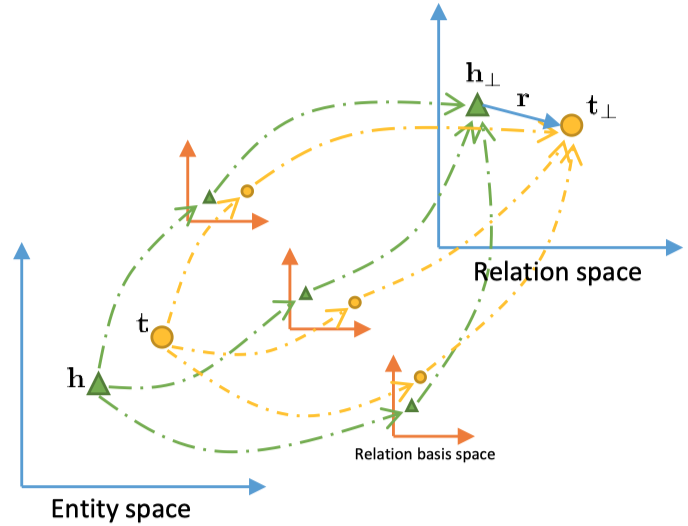
从这个图能够看出来,Circular Correlation可以看做是tensor dot的一种压缩方式,它的输出结果的每一维都是tensor dot结果的一部分。
TACT
Topology-Aware Correlations Between Relations for Inductive Link Prediction in Knowledge Graphs AAAI 2021
[个人详细博客]TACT,作者主要考虑的是inductive link prediction,使用gnn,捕获relation之间的语义上的关联性,即semantic correlation。作者认为relation之间的关联性通过relation的拓扑结构得到体现,因此,作者将所有的relation之间相连的拓扑结构分为7种,在relation形成的graph中进行学习,提出了RCN。
然后看一下整体结构:

TransF
Knowledge Graph Embedding with Multiple Relation Projections ICPR 2018
基于翻译的方法,在TransR的思想上的改进。考虑了每个relation不是独立的,而是具有Correlation,比如关系/people/person/place_of_birth和/people/person/nationality就有较强的相关性,比如居住在纽约的人大概率是美国人。为了解决这个问题,作者直接将每个relation独立的matrix分为一系列的basis space的组合,对于不同relation有不同的组合系数。

公式:
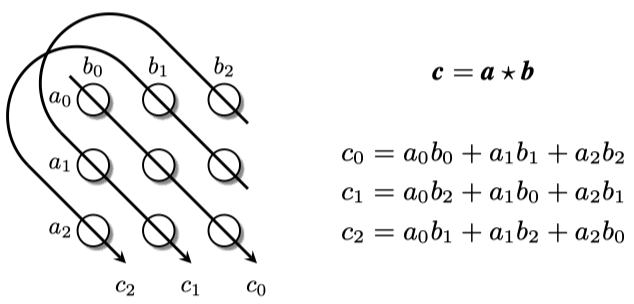
在实验中,在FB15k-237数据集上,作者使用了维度100,s数量5;在WN18RR数据集上,维度50,s数量5。最后使用TransR的方法投影:
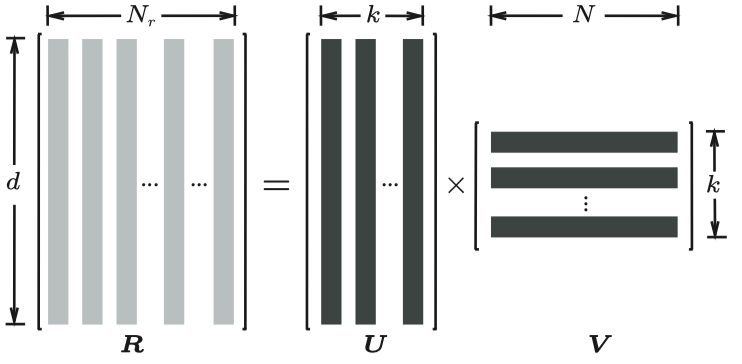
TransCoRe
Modeling the Correlations of Relations for Knowledge Graph Embedding JCST
作者考虑了关系之间的correlation,首先利用SVD和PCC方法分析了TransE这些方法学习到的relation embedding之间的相关性,然后发现在所有relation组成的matrix中,存在low-rank的structure。因此,作者直接将relation matrix拆分为两个矩阵的乘积,一个是通用矩阵,一个是关系矩阵,每一列对应不同的relation。 \[
\mathbf{R}=\mathbf{U}\mathbf{V}
\] 
在这种情况下,矩阵\(\mathbf{U}\)的列是关系空间的basis

最后

Interpreting-KGE
INTERPRETING KNOWLEDGE GRAPH RELATION REPRESENTATION FROM WORD EMBEDDINGS ICLR 2021
从最新的基于PMI(pointwise mutual information (PMI))的对于word embedding的理解角度出发,尝试从relation描述的subject和object entity的语义关联性角度进行解释;将所有的relation分为3类,并且解释了为了捕获它们的特征需要如何学习。
很多地方没看懂。
三个不同的分类:
- highly related (R);
- generalised specialisation (S);
- and generalised context-shift (C).
三者是包含关系,C>S>R
在WN18RR下不同关系的分类,
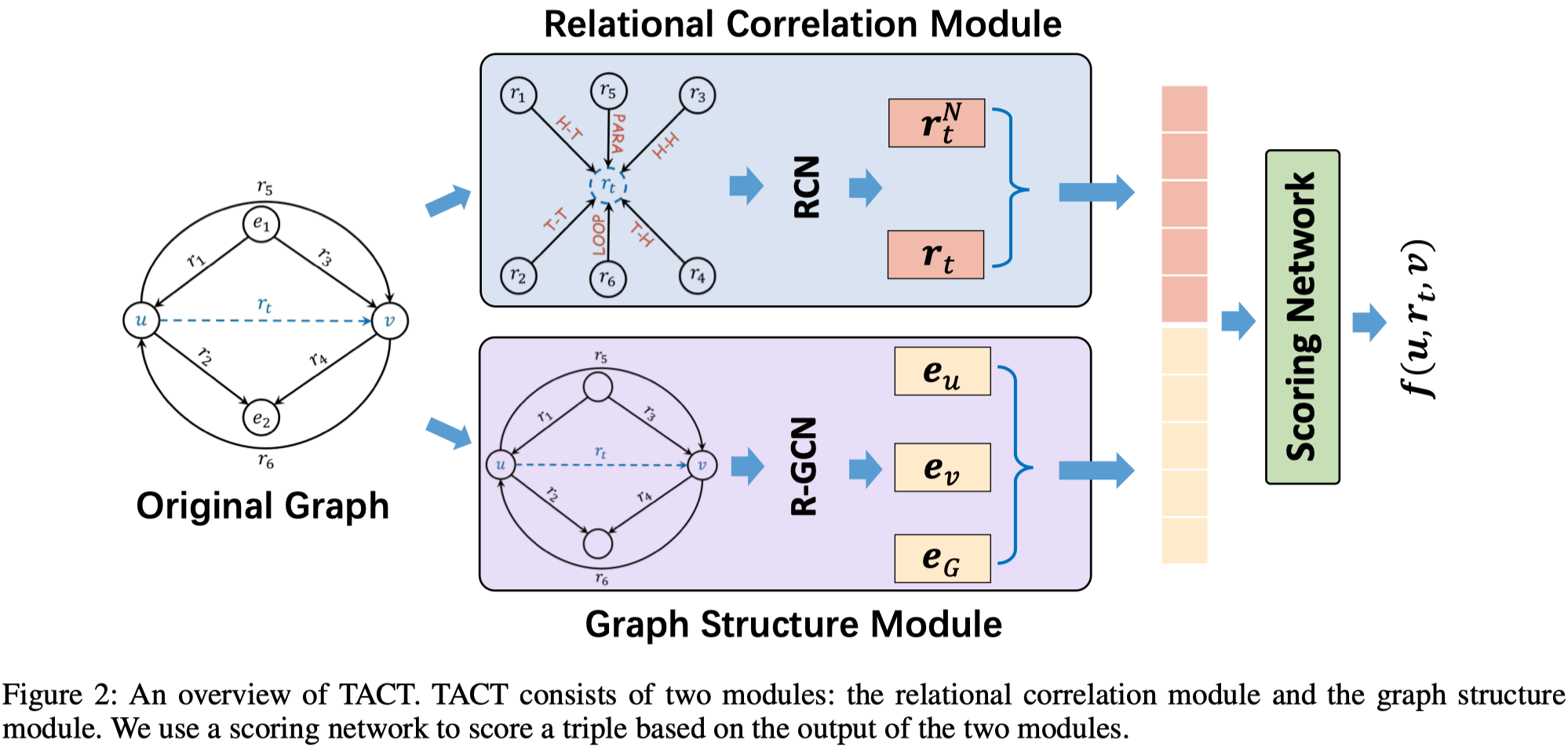
FB15k-237的relation大多是type C,也就是说该数据集中的relation没有特别明显的结构联系。
TuckER
TuckER: Tensor Factorization for Knowledge Graph Completion EMNLP 2019
这篇文章使用1996年就被提出来的分解方法 Tucker decomposition,提出了TuckER,TuckER的主要结构如下:
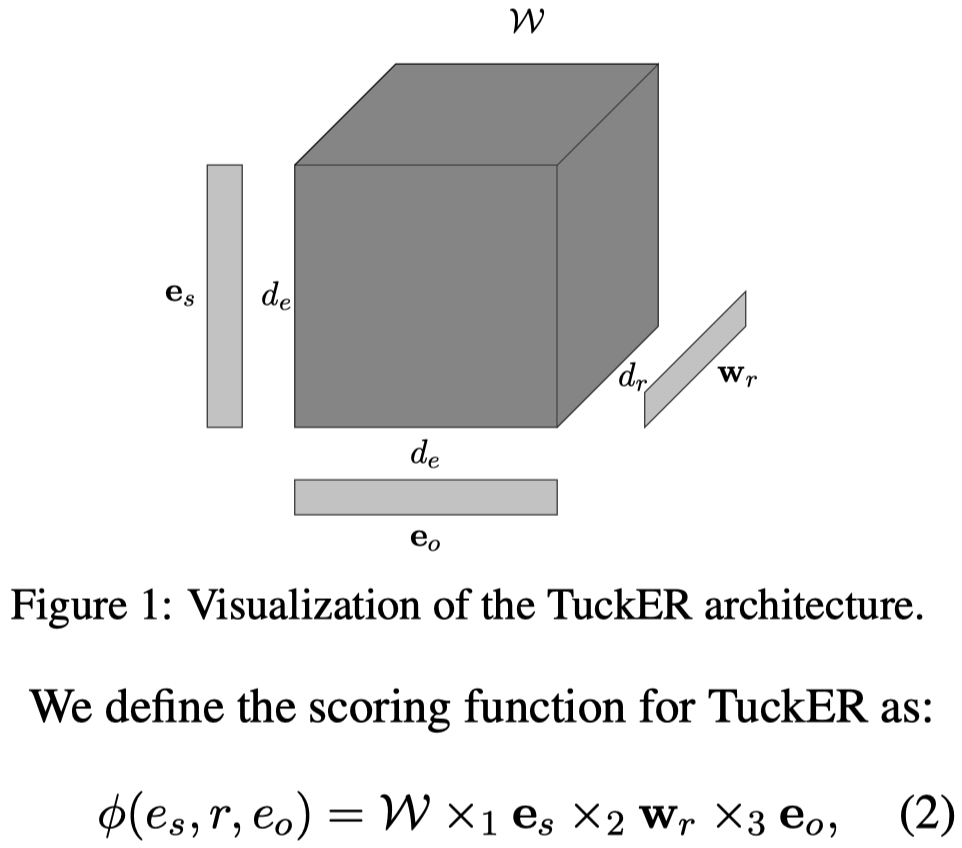
其中的参数\(W\)是所有关系共享的,\(e_s,w_r,e_o\)是subject, relation和object entity的embedding,都是向量化的表示。
具体计算公式是,沿着不同维度(mode)进行乘法运算

这篇文章可以考虑用来简化R-GCN中的\(W_r\)。
MLP for KGE
Knowledge Vault: A Web-Scale Approach to Probabilistic Knowledge Fusion KDD 2014
这篇文章介绍了Knowledge Vault
a Web-scale probabilistic knowledge base that combines extractions from Web content (obtained via analysis of text, tabular data, page structure, and human annotations)
在文章中,使用了MLP来获得KGE,主要用于评估构造的KG中的edge存在的概率,主要方法:

其中的\(\beta \in \mathbb{R}^{L\times 1}\),\(u_s, w_p, v_o\)是subject、relation和object。
TransH
Knowledge Graph Embedding by Translating on Hyperplanes AAAI 2014
这篇文章的贡献有两点
- 在TransE的基础上,提出了TransH,将subject和object entity投影到不同relation的超平面上,该超平面由一个法向量\(w_r\)决定,超平面上有一个偏移向量\(d_r\),用于算头实体和尾实体投影之间的偏移。
- 使用了一个简单基于统计的,能够减小负采样错误率的方法。原理是one-to-many的relation应该倾向于替换head entity;many-to-one的relation倾向于替换tail entity。直接统计number of tail entities per head entity和number of head entities per tail entity,然后使用二元分布,计算替换head或者tail entity的概率。这种方法区别于以前的uniform的采样,可以叫做Bernoulli采样。
TransH的结构:

数学公式:

在训练中,保证\(||w_r||_2=1\),同时\(w_r \perp d_r\)。
TransA
TransA: An Adaptive Approach for Knowledge Graph Embedding arxiv 2015
这篇文章提出了一个新的计算loss的方法,将计算欧氏距离,换为计算马氏距离。
作者认为对于以前的loss形式过于简单

缺点两个:
- 这个loss metric实际是在计算一个球面等位超面spherical equipotential hyper-surfaces,这种方式过于简单,不够灵活,泛化
Firstly, due to the inflexibility of loss metric, current translation-based methods apply spherical equipotential hyper-surfaces with different plausibilities, where more near to the centre, more plausible the triple is.
- 它实际是假设embedding的不同entry的weight在计算最终loss的时候一样
Secondly, because of the oversimplified loss metric, current translation-based methods treat each dimension identically.
作者提出的新指标,将计算欧氏距离,换为计算马氏距离:
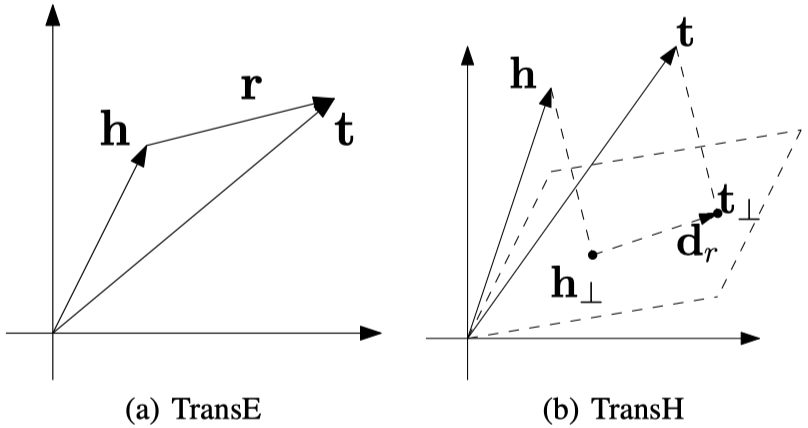
TransR
Learning Entity and Relation Embeddings for Knowledge Graph Completion AAAI 2015
这篇文章改进了TransE和TransH认为embedding都在相同的semantic space中。TransR认为不同关系具有不同的space,实体在entity space下,提出了TransR。

数学公式:
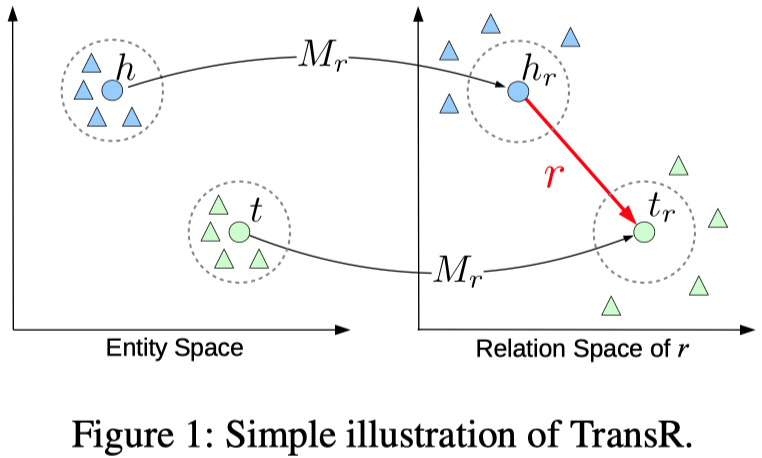
能够看到,还是有单独的relation embedding。
作者还提出了一个改进版,CTransR(Cluster-based TransR)。它对于一个单独的relation r,将不同的(head, tail)对分成几个不同的clusters,不同的clusters拥有自己的relation vector \(r_c\),整个relation下的所有clusters有一个共同的relation vector \(r\),此时的scoring function为:

TransD
Knowledge Graph Embedding via Dynamic Mapping Matrix IJCNLP 2015
作者将所有的entities和relations都赋予了两个vectors,一个vectors和以前的embedding一样,作为实体和关系的向量化embedding;一个vectors用来构件转换矩阵:


TransG
TransG : A Generative Model for Knowledge Graph Embedding ACL 2016
这是第一篇在KGE上使用generative model的论文,第一次明确提出并且讨论multiple relation semantics,即一个relation可能有不同的语义含义,这个语义含义是由它链接的头/尾实体决定的。
In spite of the success of these models, none of the previous models has formally discussed the issue of multiple relation semantics that a relation may have multiple meanings revealed by the entity pairs associated with the corresponding triples.
为了让relation有更多不同的表示,作者使用Bayesian non-parametric infinite mixture embedding model [1]的思路,为每个relation都学习多个不同的component。
[1] The indian buffet process: An introduction and review.
对生成模型不了解,这篇文章没有细读。
CP for KGE
Canonical tensor decomposition for knowledge base completion ICML 2018
https://github.com/facebookresearch/kbc
作者集中在使用canonical decomposition of tensors (also called CANDECOMP/PARAFAC or CP)来学习KGE。对于CP的改进集中在两方面:
- 引入关系的逆关系,分别具有不同的表示,显示使用这种办法能够很好的提升效果
- 使用tensor nuclear p-norms正则化CP,虽然最后结果显示没有很显著的提升CP效果
最终效果没有超越ComplEX,但是提升CP效果很多。

CP分解:

其中的\(\mathbf{X}\)是整个KG张量。
后续调研张量分解的方法可以从这篇文章出发。
SimplE
SimplE Embedding for Link Prediction in Knowledge Graphs NIPS 2018
SimplE 使用CP分解,改进了一般的CP分解,与一般的CP分解一样,每个entity有两种表示对于head和tail,每个relation有唯一的表示。在预测triple是否成立时,同时用原关系和逆关系是否成立进行平均打分。在论文中,作者证明了SimplE是fully expressivene的。

其中的\(<>\)函数是向量内积,定义为:
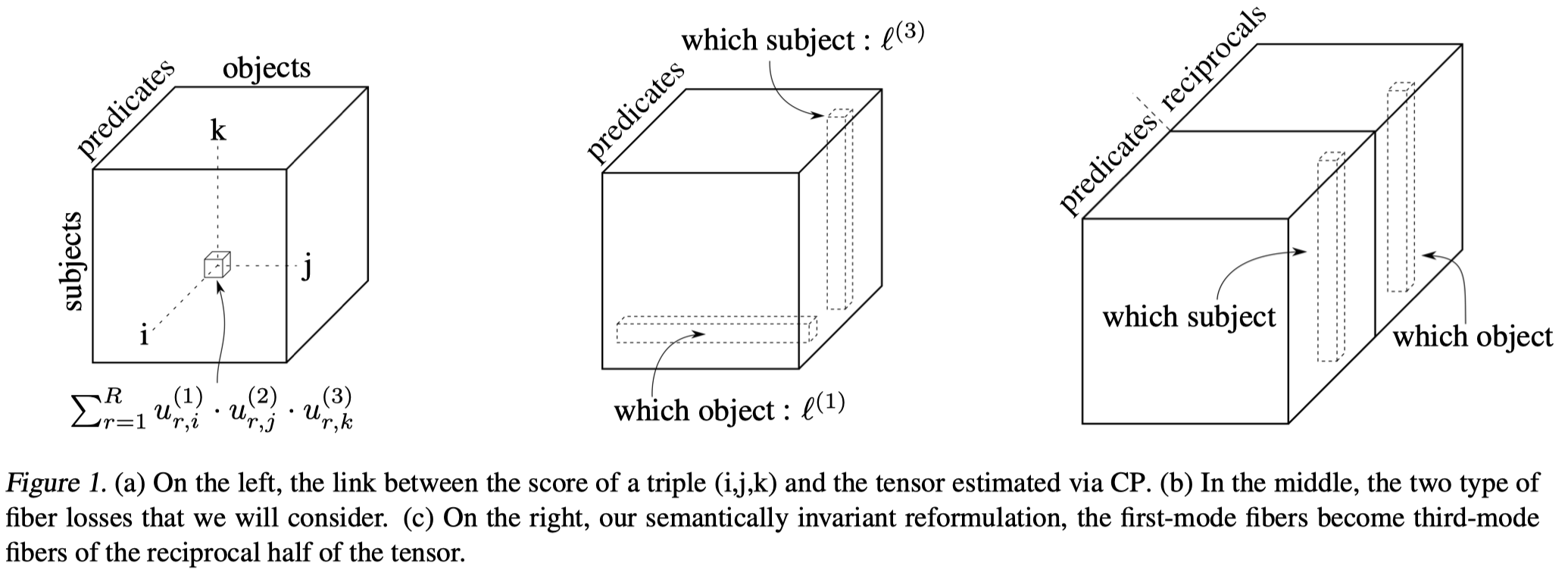
Complex
Complex Embeddings for Simple Link Prediction ICML 2016
Complex应该是首个将KGE中的embedding从实数域扩展到复数域的方法,它的思想还是基于矩阵分解的思路,但是在RESCAL和DistMult这些方法的基础上,通过引入复数域,能够建模关系的对称/不对称关系,同时还能保证参数的有效性。因为在复数域的向量内积就变为了Hermitian (or sesquilinear) dot product,拥有了一个共轭的转置表示conjugate-transpose
具体公式:
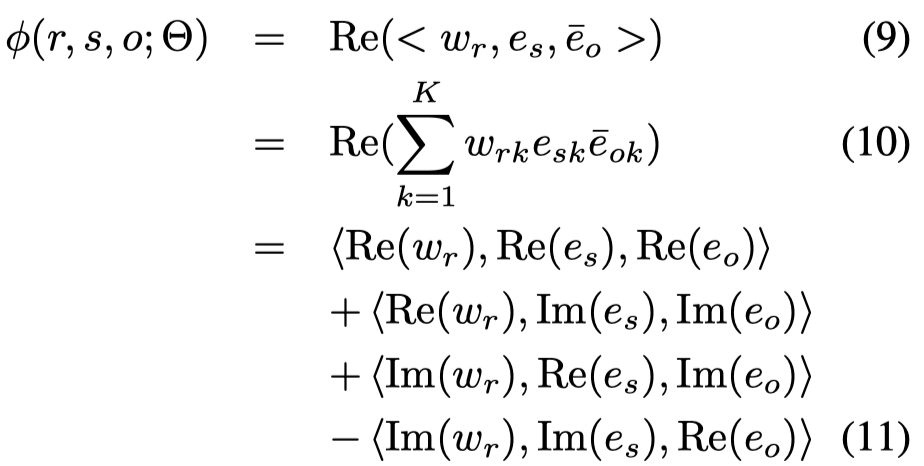
其中的,\(Re\)是实数部分,\(Im\)是虚数部分。
之后,预测概率

REInceptionE
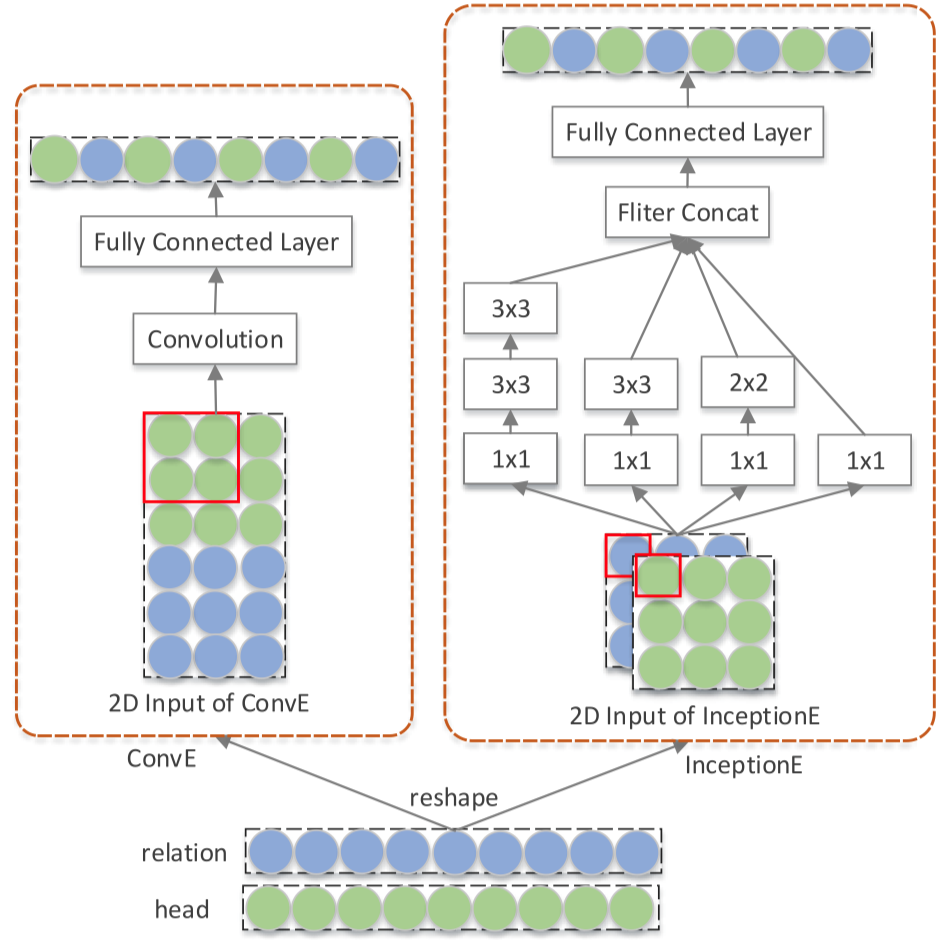
使用Inception网络学习对所有的\((h,r,?)\)都可以编码为一个embedding。
如果要查询\((h,r,?)\),\(h,r\)可以通过inception网络变为为一个查询embedding。
对于头实体\(h\)的邻居,都可以通过inception网络变为邻居embedding,之后使用查询embedding去计算邻居embedding注意力,然后进行聚合。
对于要查询的关系\(r\),对于图中所有属于\(r\)的头尾实体应该可以提供某种特定的特征,因此,利用查询embedding,计算所有属于\(r\)的头实体的注意力然后聚合;同样,聚合特定的尾实体的信息。
最后,融合三方面的信息,通过一个MLP,进行预测。
R-MeN
A Relational Memory-based Embedding Model for Triple Classification and Search Personalization R-MeN ACL 2020
为了能够记忆KG中的三元组之间可能存在的潜在依赖,提出了R-MeN方法,模型图
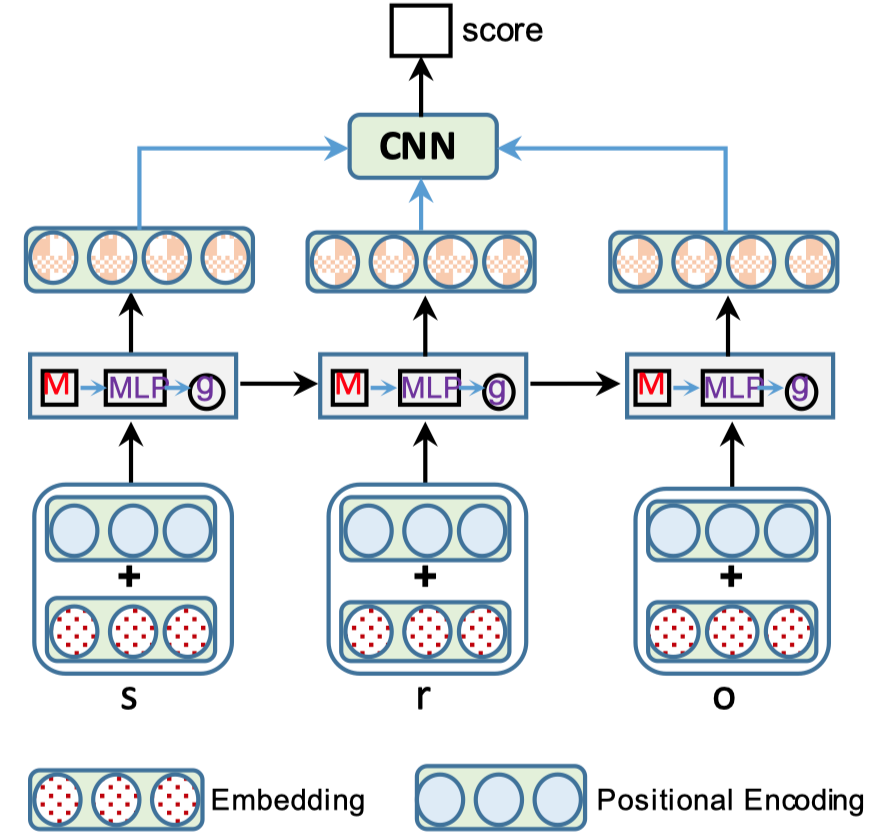
在一个三元组\((s,r,o)\)中,首先编码为三个不同的embedding

模仿Transformer加入了位置embedding。然后,设计了一个记忆力单元\(M\),设计中\(M\)应该拥有\(N\)个memory slot,每一行是一个记忆力插槽。但是在实现的时候发现只有一个记忆力插槽的时候效果最好。
之后,依次输入\(x_t\),使用transformer的注意力机制聚合\(x_t\)和\(M\)。
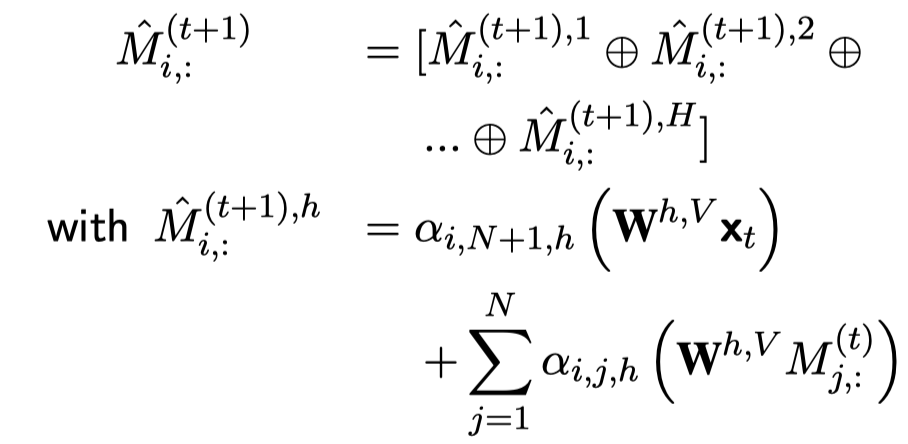
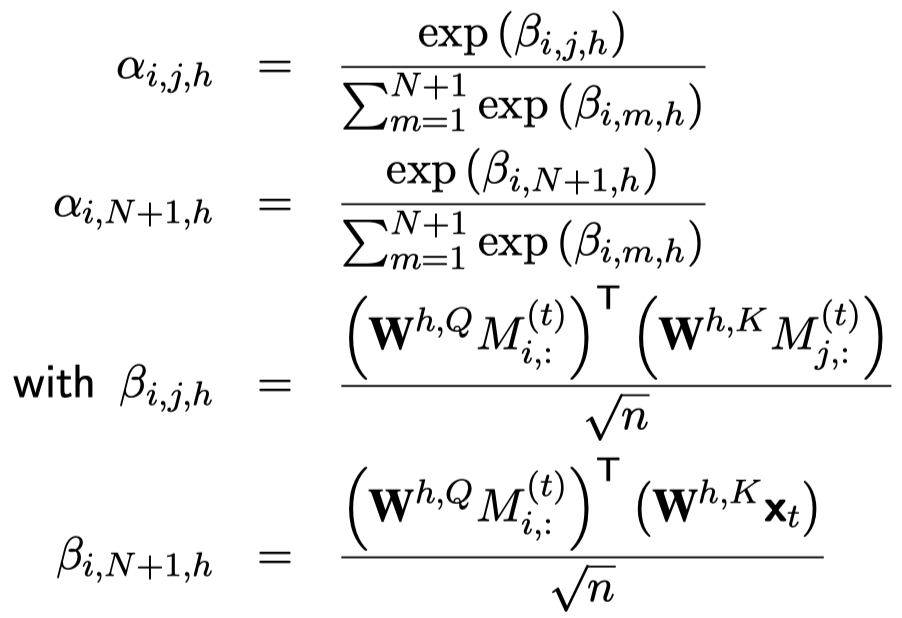
在这个之后,加入了MLP,残差,gate。实际从结果来看,没有特别大的提升。
HypER
Hypernetwork Knowledge Graph Embeddings ICANN 2019
这篇文章在ConvE的基础上改进,提出了HypER,使用relation embedding通过一个hypernetwork(Hypernetworks. In: International Conference on Learning Representations.)为每个关系都产生一个1D卷积核。和ConvE有的区别是不使用2D的卷积,不需要reshape entity embedding和relation embedding。作者另外证明了这种1D卷积的方法最终可以归类到tensor factorization中。
A hypernetwork is an approach by which one network generates weights for another network, that can be used to enable weight-sharing across layers and to dynamically synthesize weights given an input.
结构图:

核心公式:

其中的\(vec^{-1}\)是重新将向量转化为矩阵形式。\(w_r\)就是relation embedding,它的实际维度与entity embedding维度一致。
从tensor operation的角度看HypER。

RSN
Learning to Exploit Long-term Relational Dependencies in Knowledge Graphs ICML 2019
使用带残差的RNN的方法建模KG的relational path,预测实体对齐和链路预测两个任务。
核心的模型结构,首先提出了一种Biased random walk sampling,偏好采用更深的实体路径,输出relational path。
然后使用RSN(Recurrent skipping network)建模这个path,核心思想在于强调relational path中triple的重要性。将subject entity的hidden state作为残差输出到object entity的上一步hidden state中。一个relational path元素个数为奇数,头尾都是实体,\((x_1,\dots,x_{odd})\)。

然后,对实体和关系做区别对待:

模型结构:
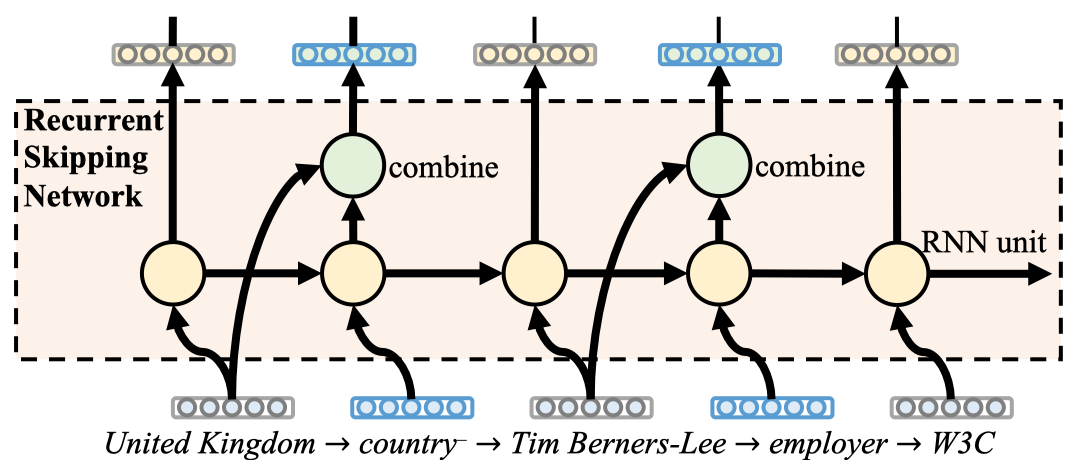
使用Type-based noise contrastive estimation(NCE)进行优化,对这个优化方法没有很了解。
NSCaching
NSCaching: Simple and Efficient Negative Sampling for Knowledge Graph Embedding ICDE 2019
[个人详细博客]提出了一种针对KGE的动态负采样方法NSCaching,核心思想是得分高的负样本很重要但是数量少,因此,作者直接使用cache来保存得分高的负样本,同时随着训练动态更新cache,可以看做是基于GAN的负采样方法的distilled版本。
在训练KGE的时候,负样本的质量很重要,也就是说那些越难与正样本区分的负样本可能越重要。high-quality negative triplets should have large scores,因为基于embedding的model实际上对于大多数负样本不敏感,给出的都是比较低的打分。如果使用random采样,采样得到的负样本,激活函数如果是sigmoid函数,那么如果负样本得分在<<0的区间内,那么梯度会很小,造成梯度消失的问题。

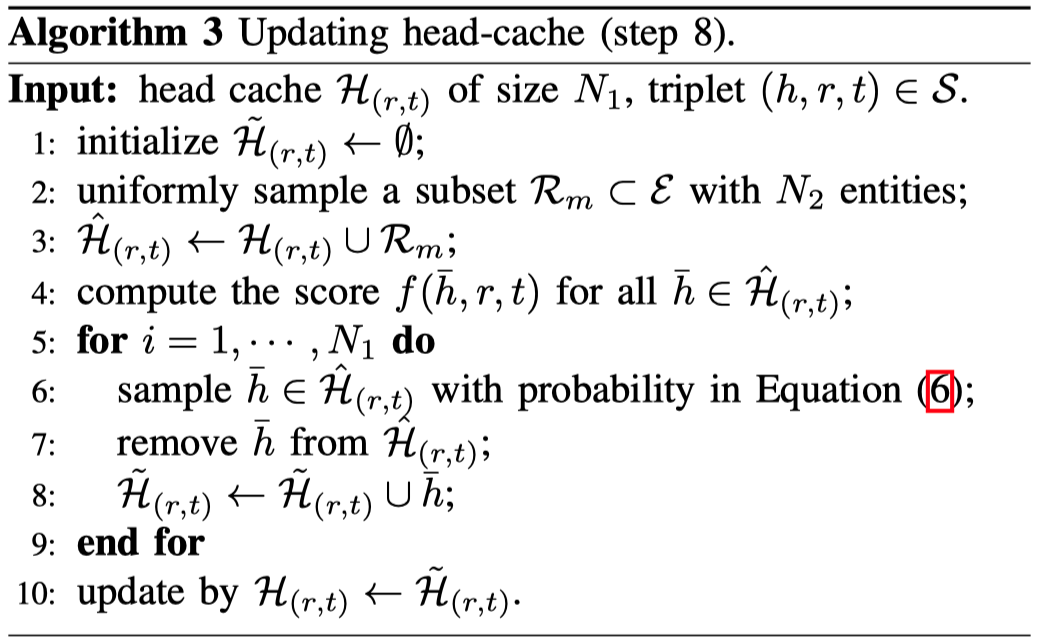
StructurE
Structural context-based knowledge graph embedding for link prediction Neurocomputing 2022
这篇文章是基于trans的KGE方法,它对于两个预测任务\(<h, t, ?>\)和\(<?, r, t>\)分别设计了不同的score function。
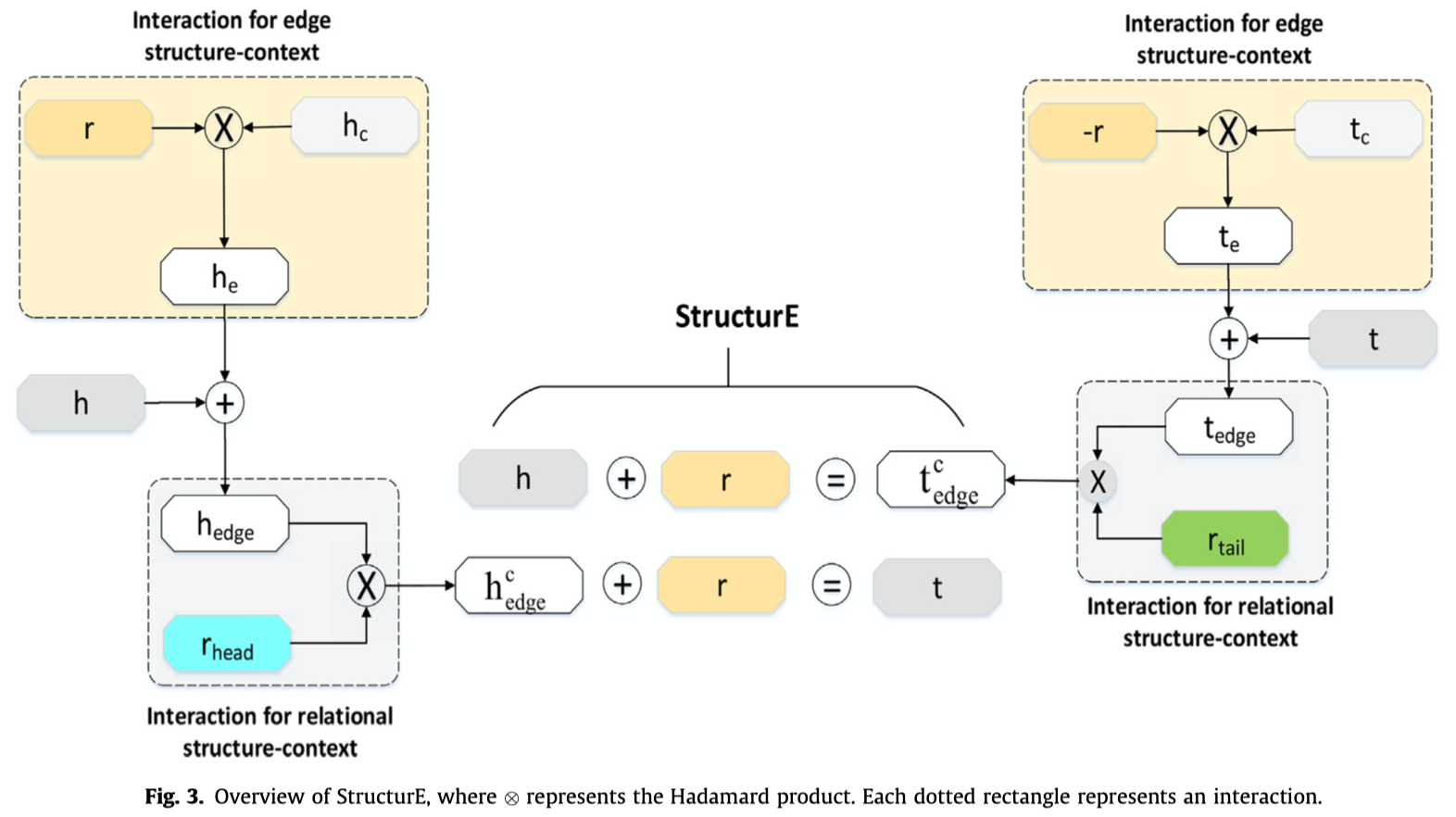
核心是两个公式:

